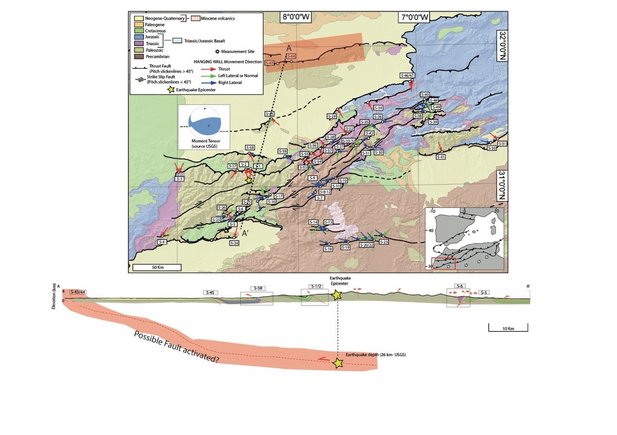According to the GFZ's GEOFON global seismological network, the earthquake struck at 23:11 local time on Sept. 8th (time in Germany: 0:11 on Sept. 9th) at a depth of 27km. It occurred in the north western sector of the High Atlas mountain range in Morocco. Its magnitude was 6.9. Analysis of the seismograms shows that the earthquake occurred on a reverse fault which means that the block above the fault moves up relative to the block below the fault. This fault movement is caused by compressional forces and results in shortening. According to the measured magnitude (Mw=6.9), the fault responsible for this earthquake ruptured over an area of about 20km x 30km. Focal mechanism (source USGS) reveals a shallow fault plain (ca 20°) located at a significant depth of ca 26-30 km. Analysis of the fault system in the region suggest that the fault involved in this seismic event emerges on the surface further north respect to the epicenter, probably north of Marrakech city, where the ancient rift shoulder is located (see fig., Lanari, R. et al. (2020)).
Seismotectonics of the region
The convergence rate between Eurasia and Nubian (African) plate is only 4 mm per year, and this is not taken up by a single plate boundary but several broader zones of activity, of which the Atlas mountains are the southernmost zone. The Gulf of Cadiz - Strait of Gibraltar - Alboran Sea form the northern limit. The High Atlas mountain range was formed by inversion of a pre-existing extensional structure, a Triassic rift, and accommodates shortening produced by the motion of the Nubian plate towards Eurasia. The seismic activity is distributed on a system of thrust (compressional) and strike slip fault (lateral motion). Since the rate of shortening is slow, the recurrence time of a big earthquake is large with respect to other regions. Recurrence rates of earthquakes of the size of Morocco earthquake on individual faults are in the thousands of years.
Large earthquakes in Morocco
Two smaller but highly damaging earthquakes have occurred in Morocco in the last century: Al Hoceima (Mw=6.3, 2016) and the Agadir earthquake (Mw=5.8, 1960). The Agadir earthquake (1960) killed around 12,000 people, at the time a third of the city's population. Hence for Morocco, this earthquake was the largest one of the 20th and 21st centuries (magnitude 6.8), but not the most destructive one. The last earthquake of possibly comparable size in Morocco was probably in 1624 near Fez.
Regulations in the affected area
Since 2004, Morocco has had a seismic building code (RPS 2000), which was revised in 2011. Another seismic regulation specific to earth construction has been in force since 2014. The area affected last night is in zone 3 of the seismic building code. Zone 3 is the zone with the most stringent seismic regulations. The region of High Atlas was identified as risky by the authorities and the scientific community. The rate of deformation of individual faults is however low and therefore the interval between damaging earthquakes is long (over 100 years). Thus, the population may unfortunately have been taken by surprise.
Quick facts:
F-E Region: Morocco
Magnitude: 6.9 (Mw)
Epicenter: 8.41°W 31.14°N
Depth: 27 km
Time (Coordinated Universal Time): 2023-09-08 22:11:02 UTC
Local time – Epicenter: 2023-09-08 23:11:02 GMT+1
Time in Germany: 2023-09-09 00:11:02 MESZ
Status: M - manually revised
Current Earthquake Information:
The GEOFON network operated at the GFZ provides seismic data and earthquake parameters via the Earthquake Explorer. In addition to the German Research Centre for Geosciences, numerous partner institutions are involved in the global measurement network.
* This news item was supplemented on 15.9.2023. Existing information has not been changed.


![[Translate to English:] Screenshot from Earthquake Explorer. You can see a map of Marrocco, with the epicentre marked as a circle](/fileadmin/_processed_/b/8/csm_Morocco_earthquake_2023_09_08_7bfeb1954b.png)







![[Translate to English:] Gruppenbild mit 4 Personen](/fileadmin/_processed_/8/d/csm_20241017_GFZ-Emmerman-Medal-005_web_reinhardtundsommer_21a414fa4a.jpeg)






![[Translate to English:] Ice landscape with five red tents](/fileadmin/_processed_/8/9/csm_Zeltlager_auf_dem_Eis_Urheberin_Jenine_McCutcheon_5ced2d523b.jpeg)














![[Translate to English:] Group photo with 7 people in front of a new metal plant in a large laboratory hall.](/fileadmin/_processed_/0/4/csm_20240628-GFZ_Einweihung_Triax-Anlage-PRESSE_Abb1_040_c-Bahlo-GFZ_187906cb48.jpeg)




![[Translate to English:] Heidi Kreibich, woman with short brown hair and blue eyes. She is wearing a grey cardigan and a red polo shirt](/fileadmin/_processed_/6/6/csm_kreibich-Heidi_1_Querformat_he-2021_2dedd3ef33.jpeg)

